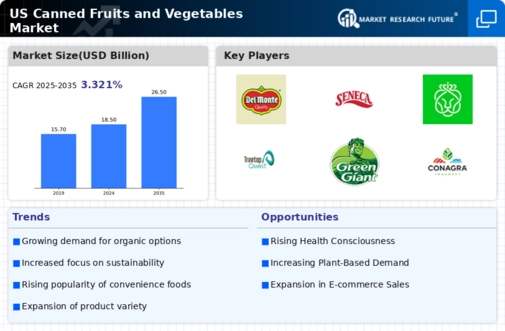Expansion of Retail Channels
The canned fruits-vegetables market benefits from the expansion of retail channels, which enhances product accessibility for consumers. Supermarkets, convenience stores, and online platforms are increasingly stocking a diverse range of canned products. This trend is supported by data showing that online grocery sales have surged, with a significant portion of consumers opting for the convenience of home delivery. As a result, manufacturers are likely to collaborate with retailers to ensure their products are prominently displayed and easily accessible. This increased availability not only boosts sales but also raises consumer awareness of the benefits of canned fruits and vegetables, potentially leading to higher consumption rates.
Increased Focus on Nutritional Value
The canned fruits-vegetables market is witnessing a shift towards products that emphasize nutritional value. Consumers are becoming more health-conscious, seeking foods that provide essential vitamins and minerals. This trend is reflected in the growing popularity of canned vegetables that retain their nutritional content during the canning process. Research indicates that canned vegetables can be as nutritious as fresh ones, making them an attractive option for health-oriented consumers. Furthermore, the market is seeing an increase in the availability of organic and low-sodium canned options, catering to specific dietary needs. This focus on nutrition is likely to drive innovation in product formulations, enhancing the appeal of canned fruits and vegetables in the competitive food landscape.
Rising Demand for Shelf-Stable Foods
The canned fruits-vegetables market experiences a notable increase in demand for shelf-stable food products. This trend is driven by consumers seeking convenience and longer shelf life in their food choices. According to recent data, the market for canned fruits and vegetables is projected to grow at a CAGR of approximately 4.5% over the next few years. This growth is attributed to the busy lifestyles of consumers who prefer ready-to-eat options that require minimal preparation. Additionally, the extended shelf life of canned products reduces food waste, appealing to environmentally conscious consumers. As a result, manufacturers in the canned fruits-vegetables market are likely to innovate and expand their product lines to meet this rising demand, ensuring a diverse range of options for consumers.
Growing Popularity of Plant-Based Diets
The canned fruits-vegetables market is benefiting from the growing popularity of plant-based diets among consumers. As more individuals adopt vegetarian and vegan lifestyles, the demand for plant-based food options, including canned fruits and vegetables, is on the rise. This trend is supported by research indicating that plant-based diets can contribute to improved health outcomes. Consequently, manufacturers are likely to expand their product offerings to include a wider variety of canned plant-based options, catering to this evolving consumer preference. The increased focus on plant-based eating not only supports the growth of the canned fruits-vegetables market but also aligns with broader trends in health and sustainability.
Adoption of Innovative Packaging Solutions
The canned fruits-vegetables market is experiencing a transformation due to the adoption of innovative packaging solutions. Manufacturers are increasingly utilizing advanced technologies to enhance the shelf life and quality of their products. For instance, vacuum-sealed cans and BPA-free packaging are becoming more prevalent, addressing consumer concerns regarding food safety and environmental impact. This shift towards sustainable packaging options is likely to resonate with eco-conscious consumers, thereby driving sales in the canned fruits-vegetables market. Additionally, attractive and functional packaging designs can enhance product visibility on retail shelves, further encouraging consumer purchases. As a result, the market may see a rise in competition among brands striving to differentiate themselves through packaging innovations.





















Leave a Comment